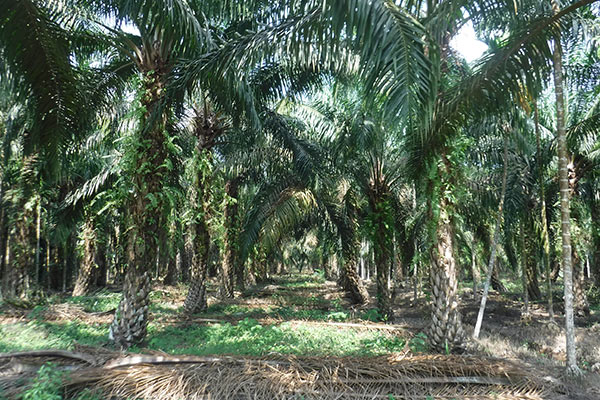Enhancing the Benefits of Tropical Peatland Restoration for Supporting Local Communities and Ecosystem Processes

This project aims to understand the consequences of draining peatlands for biodiversity and local livelihoods, and to examine different scenarios for prioritising peatlands for restoration, according to biodiversity and emissions considerations and local community benefits and trade-offs.
Context
Peat swamp forests contain particularly large stores of carbon and support unique flora and fauna not occurring elsewhere, but have been drained and degraded to make way for agriculture, threatening wildlife and releasing large amounts of carbon into the atmosphere from loss of trees and soil.
Much of this recent forest loss is due to conversion to oil palm plantations, which provide important sources of local incomes, although drained peatlands produce many ecosystem disservices, including enhanced risk of catastrophic fires, and greenhouse gas emissions. Thus, there are moves to rehabilitate degraded peatlands with a focus on reducing emissions and fires, but potential co-benefits (and risks) of restoration for biodiversity and consequences for local communities whose livelihoods are dependent on agriculture are not well understood.
Restoration of degraded peatlands through revegetation and re-wetting of drained agricultural areas may remove agricultural areas from production, or reduce agricultural productivity, thereby reducing smallholder farmer incomes. Moreover, decisions about sites to restore need to be compatible with systems of local governance, land rights and devolved administrations, and require the identification of alternative livelihood options for communities in restored areas.
The size and degree of connectivity of forest areas is also important for maintaining population networks of species in degraded landscapes, and for promoting the responses of biodiversity to climate change, and so decisions about locations for forest restoration also need to include consideration of connectivity and adaptation of species to climate change.
Aims and objectives
The aim of this project is to understand the consequences of draining peatlands for biodiversity and local livelihoods and to examine different scenarios for prioritising peatlands for restoration, according to biodiversity and emissions considerations and local community benefits and trade-offs.
We are studying peatlands in Sumatra, and focusing our field studies in Jambi Province, selected because it is part of the single largest contiguous area of deep peat soils in SE Asia and contains substantial deforested areas, production forests, agricultural areas, as well as some pristine peat swamp areas.
This information will allow us to better understand the biodiversity and ecosystem services of peatland ecosystems, the socio-economic effects of peatland restoration effects, and how connectivity could be restored in order for remaining peat forest habitats to be more resilient.
Findings and outcomes so far
Project activities and publications
To get further updates visit the project blog
Related links
To find out more visit the project website
- Prof Jane Hill (Principal Investigator)
- Dr Eleanor Warren-Thomas (Postdoctoral Research Assistant)
Principal Investigators
- Prof Jane Hill, Department of Biology, University of York
- Dr Fahmuddin Agus, Indonesian Soil Research Institute, ICALRRD/BBSDLP
Researchers and Co-Investigator
- Dr Colin McClean, Department of Environment and Geography, University of York
-
Dr Eleanor Warren-Thomas, University of York
- Dr Caroline Ward, University of Leeds
- Merry Crowson, Institute of Zoology, Zoological Society of London
- Dr Mailys Lopes, Institute of Zoology, Zoological Society of London
- Professor Keith Hamer, University of Leeds
- Professor Lindsay Stringer, University of Leeds
- Dr Jenny Hodgson, University of Liverpool
- Dr Nathalie Pettorelli, Institute of Zoology, Zoological Society of London
- Dr Asmadi Saad, Peat Restoration Agency (BRG)/Jambi University
- Dr Bambang Hariyadi, Jambi University
- Ms Winda Dwi Kartika, Jambi University
- Dr Jennifer Lucey, University of Oxford
- Dr Etty Pratiwi, Indonesian Soil Research Institute, ICALRRD/BBSDLP
- Dr Neneng Laela Nurida, Indonesian Soil Research Institute, ICALRRD/BBSDLP
- Dr Maswar, Indonesian Soil Research Institute, ICALRRD/BBSDLP
- Dr Ai Dariah, Indonesian Soil Research Institute, ICALRRD/BBSDLP
- Dr Setiari Marwanto, Indonesian Soil Research Institute, ICALRRD/BBSDLP
- Ms Ratri Ariani, Indonesian Soil Research Institute, ICALRRD/BBSDLP
- UK Research and Innovation (UKRI)
- Newton
- University of Leeds
- University of Liverpool
- Zoological Society of London
- Indonesian Centre for Agricultural Land Resources, Research and Development (Java)
- University of Jambi (Sumatra)
- SE Asia Rainforest Research Programme
- Van Hall Larenstein University
Related links
To find out more visit the project website